
Bringing a dog into your home is so exciting! You’ve probably been dreaming of this moment for months—maybe years! And now your new pup is finally home.
But he seems so scared. And you’re not sure why!
Whether you picked up your dog from a rescue shelter or a breeder, it might be confusing as to why he’s so scared. The fact is, this is all new to your dog! Imagine if someone took you away from the life you knew and brought you to a strange new place full of people you don’t know. You’d be scared too!
No matter where your dog came from, you have to build trust with him. And while his fearfulness might make it seem like you’ll never get anywhere with your dog, that can’t be further from the truth.
Here are a 12 tricks and tips to help your scared dog learn to trust you.
Table of Contents
How to Get a Scared Dog to Trust You
Okay, let’s dive right in. Here are the 12 tips to get a scared dog to trust you.
1. Be Calm
Dogs are very emotional creatures. They will pick up easily on what you’re feeling. And, if you’ve just brought a rescue dog who is scared of everything into your home, he’ll already be on high alert. That means that any extreme reaction you have is going to affect him.
So it’s super important to stay calm. You might want to act super excited to make your dog happy to be in his new home. But being too energetic will probably just scare your dog even more!
Right now, the most important thing is for your dog to feel safe and comfortable. By acting calm, you’ll help him settle down and start trusting you.
2. Give Your Dog Time
One of the most important things when it comes to a scared dog is patience! Dogs don’t speak the way we do, unfortunately, so we can’t just tell them they’re safe. They have to learn these things on their own.
So, while your dog adjusts to his new life, just be patient. Give him time to get used to everything. And don’t push your dog to do anything he doesn’t want to—that will just scare him more.
It will take time, but remember to be patient. With your help, your dog will start learning to trust you.
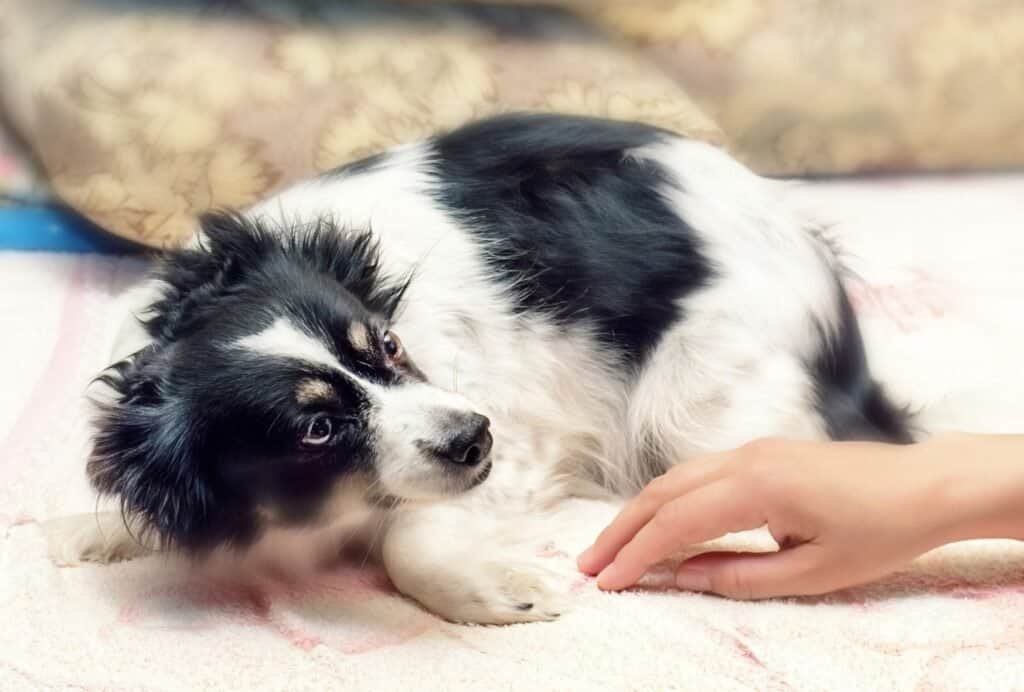
3. Give Your Dog Space
If your dog keeps hiding away from you, you might be trying to track him down and get him to spend time with you. After all, how is he going to get used to you if he isn’t around you?
Well, the fact is that your dog is hiding because he’s scared. And if you keep chasing him down, he’s going to feel trapped, which will scare him even more. In severe cases, your fearful dog might even become aggressive.
That’s why it’s really important to give your dog space while he gets used to his new life. He needs to go at his own pace, and as hard as it might be for you, you need to let him do that.
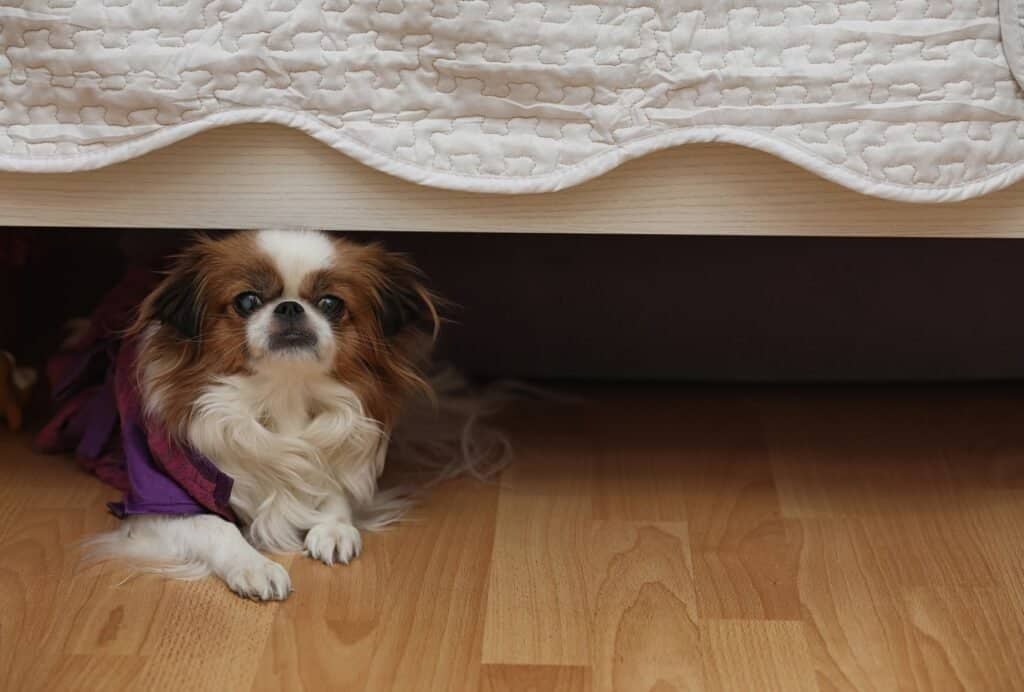
4. Talk Little and with a Calm Voice
Even though dogs don’t speak the same way we do, they’re very good at picking up on tones. If you’ve ever been around a dog that feels comfortable around people, then you know speaking in a loud, excited tone will make that dog excited too!
That’s great for a dog that feels comfortable. But for a scared dog excitement is the very last thing he needs. If you can, try not to speak much at all, at least at first. When you do speak, use a calm, quiet voice.
Don’t worry, you won’t have to do this forever. In time, you can start speaking normally again. But for now, while your dog adjusts, speak calmly and quietly.
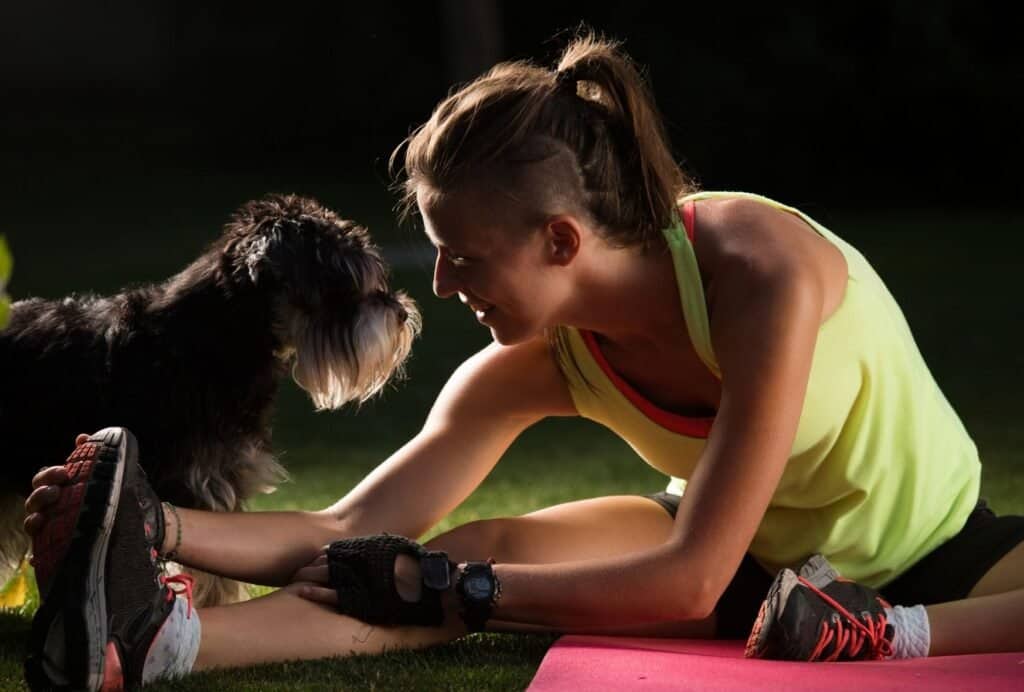
5. Avert Your Eyes
Dogs don’t speak the same way we do. While barking, whining, and growling are all ways they communicate, body language is their primary way of communicating with us and other dogs.
Eye contact is a major component in body language. For that reason, you should understand what different kinds of eye contact mean. When you stare directly into your dog’s eyes, that can be a sign of dominance.
A fearful dog won’t take well to that, and will become even more scared if he thinks you’re trying to dominate him. He might even lash out.
So, while eye contact with your dog can also be a sign of love, you need to consider the context. Right now, your dog is scared! For the time being, it’s best to avert your eyes to help your dog feel more comfortable.
6. Offer Your Side
This also has to do with body language. Just like with making direct eye contact, coming at your dog head-on might make him feel threatened or nervous. For a scared dog, that’s not helpful.
Instead, offer your dog your side when you greet him. This will make your dog feel more comfortable, and less intimidated. By doing this, you’ll be showing your dog that you’re not trying to intimidate or dominate him, and he’ll be much more comfortable approaching you.
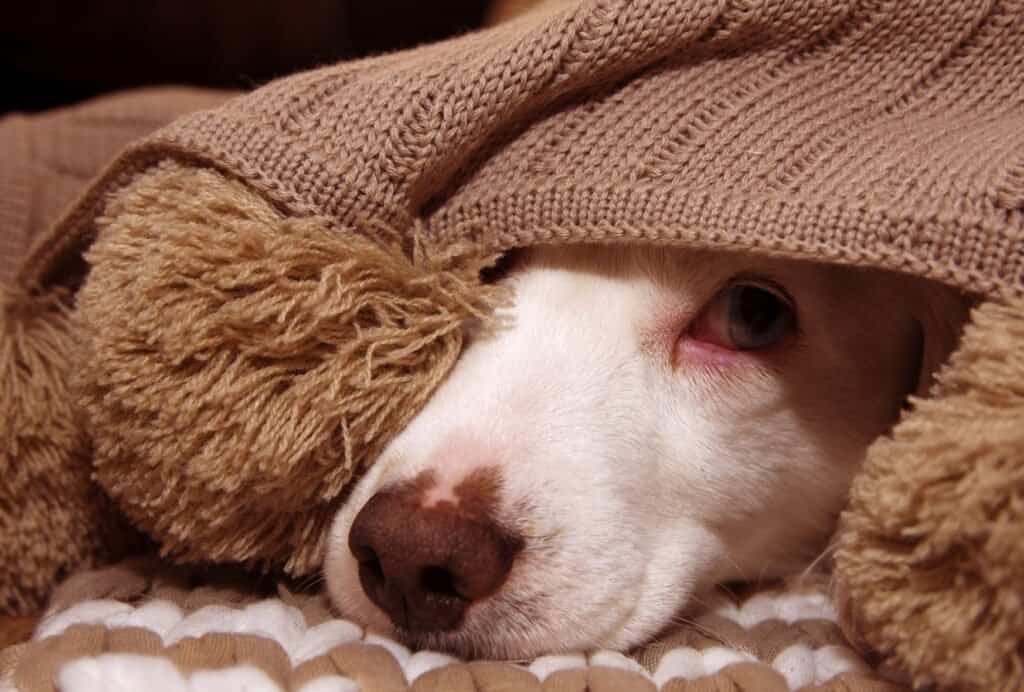
7. Toss Some Treats Around
What dog doesn’t love food? When you bring your new dog into your home, make sure you’ve always got some treats on hand.
It’s not enough to just make sure your dog doesn’t have any negative feelings about you. You also want to seriously up the positive associations. And there aren’t many better ways to do this than by giving him treats!
So while you’re around your dog, grab some treats and toss a few around you. This will get your dog to approach you, and it will also get him to form positive feelings about being near you.
Getting close to you means he gets treats, after all. And the more you do this, the more you’ll find that your dog wants to be close!

8. Get on Your Dog’s Height
Just imagine if you were a dog and taken to a strange new place, full of sights, smells and sounds you weren’t used to. Everything’s different and weird.
And to make things even scarier there is this big two-legged thing towering over you all the time! Having that happen to you would seem pretty intimidating.
That’s exactly how your dog feels!
To help him get used to his new environment and, more importantly, get used to you, try getting down on his level. Make sure not to crowd him when you do, as that might scare him even more. Give your dog his space, but try to stay at his height to help him feel more comfortable.
9. Let Your Dog Approach You
It’s super important not to rush your dog into anything. You might want to help him get used to you by approaching him and forcing him to be near you. After all, how is he going to start trusting you if he’s avoiding you?
In truth, crowding him is one of the worst things you can do! Again, if your dog feels trapped, he’ll only get more scared. Plus, he might lash out if he feels like he has no other option.
Instead, let your dog approach you. It all comes down to making sure you’re going at your dog’s pace. Just be patient and keep following all these tips.
It might take a while, especially if your dog comes from a shelter or rescue after being removed from an abusive home. Getting an abused dog to trust you can be a long, challenging process, but in time he’ll get there!
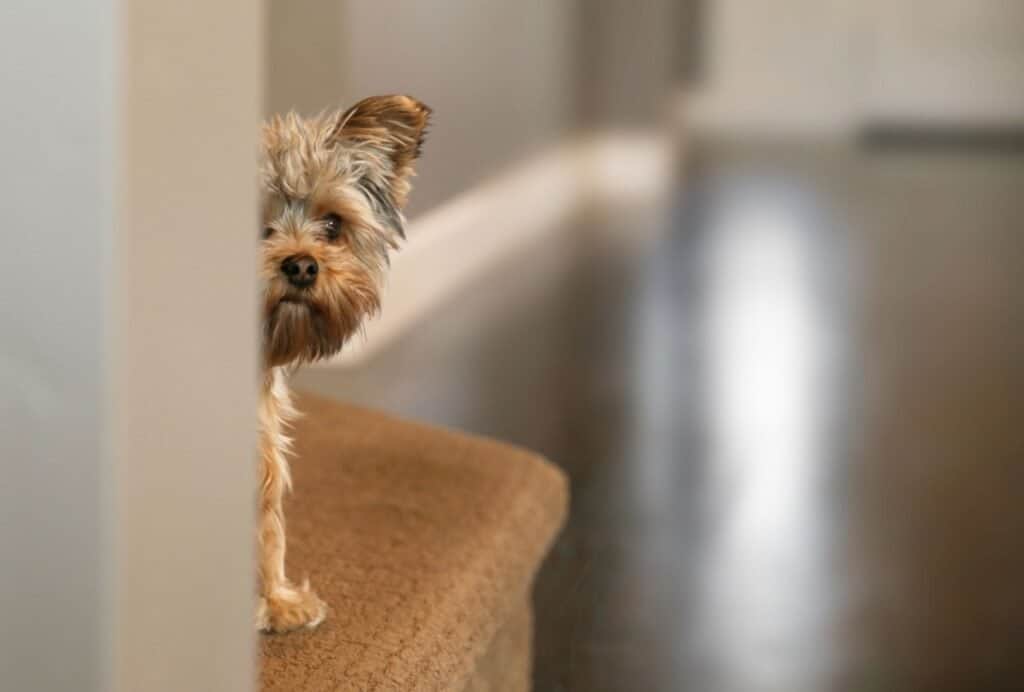
10. Slowly Pet Him on His Cheek and Under His Ears
Once your dog is comfortable approaching you, try giving him some love by petting him. Move slowly as you do this, and let him watch your hand.
Dogs like being pet because it feels good to them. Petting your dog also helps the two of you bond! So it’s important to get to a point where you can pet your dog.
Of course, at first he’ll probably be nervous about it, especially if he comes from a situation of physical abuse. Just go slow and be patient. If your dog moves away or starts showing signs of discomfort, back off right away.
Petting him on his cheek and under his ears is a good place to start because he can see your hand which will make him less nervous.
Don’t pet him on his head at first. Your hand coming from above might be intimidating, especially if he was abused. That might remind him of a hand hitting him…
11. Use Positive Reinforcement
Positive reinforcement isn’t just for training. It’s also a really good way to get your dog used to situations where he’s uncomfortable!
Positive reinforcement involves encouraging your dog by getting him to form positive associations. You do this by praising your dog when he does something good or something you like.
When you do this, your dog will learn that being close to you results in good things for him, like treats and love.
Positive reinforcement is one of the most effective ways of encouraging certain behaviors in your dog. It’s also a great way to form a bond with him and get him to trust you.
12. Use Games to Build Confidence
Once you’ve built your bond to a point where you can play with your dog, playing games to build confidence is your next step.
If your dog is scared, he probably doesn’t have a lot of confidence. That’s something you’re going to want to fix if you want your dog to be happy and healthy!
Playing brain games is one of the best ways to help your dog build confidence. If you’re looking for some ideas of what you can play, here are 10 brain games for dogs to play at home.
Mental stimulation can also be a wonderful training tool if used correctly. Check out Braintrainingfordogs to learn how to train your dog to be the best dog he can be by using mental stimulation! Or have a look at Dogpackr’s review first to see if it’s a fit for you and your dog!

How to Help a Fearful Dog Gain Confidence
One of the best ways to help a fearful dog gain confidence is through positive associations.
If you know what it is that scares your dog, try removing that stimulus completely. Then, slowly reintroduce it in controlled ways. As you expose your dog, give him a lot of treats to help him associate the thing that scares him with things that he likes!
Some dogs that come from abusive or neglectful homes can be very scared of people. Always remember that you are your dog’s voice. If your dog is too nervous for strangers to pet him, you can tell people “No” until you’ve worked up to a point where he’s more comfortable.
The other good way to help your dog gain confidence is by playing games or teaching him new tricks. The more he understands that he can actually be a good boy, the more confident he’ll get.
What If My Dog Is Too Scared to Take Treats?
If your dog is too scared to take treats, there are a few things you can try. First, try choosing treats of higher value. Your dog might have a preference for treats, and you might need to start him off with a high value treat to get him to accept them.
If you’re trying to give him treats straight from your hand, try tossing them on the floor a few feet away instead.
Finally, consider the situation you’re in. If your dog is in a high-stress situation, it’ll be harder for him to accept treats. Take him out of that situation and give him treats in a context that has less stress. Then, slowly build back up to the more challenging situation.
How to Get an Aggressive Dog to Trust You
When it comes to aggressive dogs, the thing to understand is that the aggression is coming from fear. Your dog doesn’t think he has any other choice to keep himself safe, which is why he’s lashing out!
Your best bet when working with an aggressive dog are, as usual, patience and consistency. Pay careful attention to your dog to make sure you’re not overwhelming him.
Also, if you do it right, muzzle training can be very useful for aggressive dogs!
Conclusion
Bringing a new dog into your home is so exciting!
But some dogs, especially dogs that come from shelters or rescues, can be very fearful. It can be frustrating, but remember that your dog has been through a lot, and you’d be scared too if you were in his paws!
Just remember to be patient, consistent, and go at your dog’s pace. Over time, your dog will learn that it’s safe to be near you, and the world isn’t as scary as he thought. Even if your dog is really scared right now, he’ll learn to trust you at some point. And, more importantly, the two of you will have a strong bond for life.
P.s.: Don’t forget to check out Braintraining4dogs if you want to take your dog training game to the next level. It offers a 60-day money back guarantee, so you have nothing to lose.

*Disclosure: This post may contain affiliate links, meaning, I get a commission if you decide to make a purchase through one of my links, at no cost to you.

